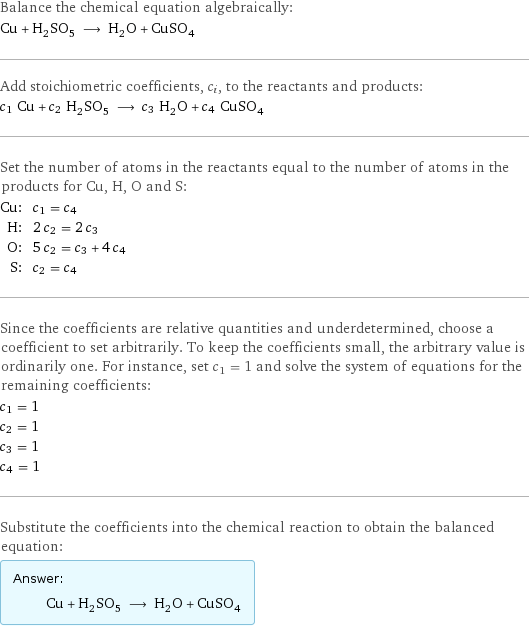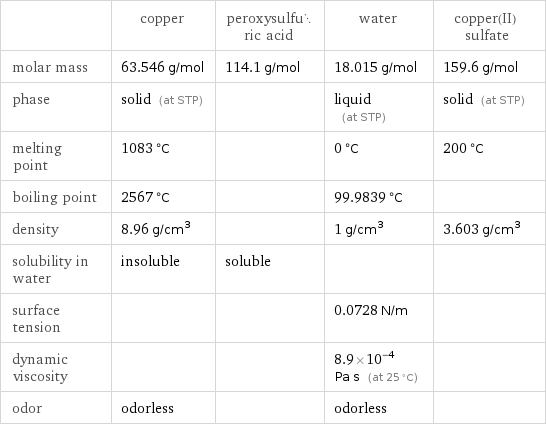Input interpretation

Cu copper + H_2SO_5 peroxysulfuric acid ⟶ H_2O water + CuSO_4 copper(II) sulfate
Balanced equation

Balance the chemical equation algebraically: Cu + H_2SO_5 ⟶ H_2O + CuSO_4 Add stoichiometric coefficients, c_i, to the reactants and products: c_1 Cu + c_2 H_2SO_5 ⟶ c_3 H_2O + c_4 CuSO_4 Set the number of atoms in the reactants equal to the number of atoms in the products for Cu, H, O and S: Cu: | c_1 = c_4 H: | 2 c_2 = 2 c_3 O: | 5 c_2 = c_3 + 4 c_4 S: | c_2 = c_4 Since the coefficients are relative quantities and underdetermined, choose a coefficient to set arbitrarily. To keep the coefficients small, the arbitrary value is ordinarily one. For instance, set c_1 = 1 and solve the system of equations for the remaining coefficients: c_1 = 1 c_2 = 1 c_3 = 1 c_4 = 1 Substitute the coefficients into the chemical reaction to obtain the balanced equation: Answer: | | Cu + H_2SO_5 ⟶ H_2O + CuSO_4
Structures

+ ⟶ +
Names

copper + peroxysulfuric acid ⟶ water + copper(II) sulfate
Equilibrium constant
![Construct the equilibrium constant, K, expression for: Cu + H_2SO_5 ⟶ H_2O + CuSO_4 Plan: • Balance the chemical equation. • Determine the stoichiometric numbers. • Assemble the activity expression for each chemical species. • Use the activity expressions to build the equilibrium constant expression. Write the balanced chemical equation: Cu + H_2SO_5 ⟶ H_2O + CuSO_4 Assign stoichiometric numbers, ν_i, using the stoichiometric coefficients, c_i, from the balanced chemical equation in the following manner: ν_i = -c_i for reactants and ν_i = c_i for products: chemical species | c_i | ν_i Cu | 1 | -1 H_2SO_5 | 1 | -1 H_2O | 1 | 1 CuSO_4 | 1 | 1 Assemble the activity expressions accounting for the state of matter and ν_i: chemical species | c_i | ν_i | activity expression Cu | 1 | -1 | ([Cu])^(-1) H_2SO_5 | 1 | -1 | ([H2SO5])^(-1) H_2O | 1 | 1 | [H2O] CuSO_4 | 1 | 1 | [CuSO4] The equilibrium constant symbol in the concentration basis is: K_c Mulitply the activity expressions to arrive at the K_c expression: Answer: | | K_c = ([Cu])^(-1) ([H2SO5])^(-1) [H2O] [CuSO4] = ([H2O] [CuSO4])/([Cu] [H2SO5])](../image_source/b72a7d98658cd58e834edebdf47add08.png)
Construct the equilibrium constant, K, expression for: Cu + H_2SO_5 ⟶ H_2O + CuSO_4 Plan: • Balance the chemical equation. • Determine the stoichiometric numbers. • Assemble the activity expression for each chemical species. • Use the activity expressions to build the equilibrium constant expression. Write the balanced chemical equation: Cu + H_2SO_5 ⟶ H_2O + CuSO_4 Assign stoichiometric numbers, ν_i, using the stoichiometric coefficients, c_i, from the balanced chemical equation in the following manner: ν_i = -c_i for reactants and ν_i = c_i for products: chemical species | c_i | ν_i Cu | 1 | -1 H_2SO_5 | 1 | -1 H_2O | 1 | 1 CuSO_4 | 1 | 1 Assemble the activity expressions accounting for the state of matter and ν_i: chemical species | c_i | ν_i | activity expression Cu | 1 | -1 | ([Cu])^(-1) H_2SO_5 | 1 | -1 | ([H2SO5])^(-1) H_2O | 1 | 1 | [H2O] CuSO_4 | 1 | 1 | [CuSO4] The equilibrium constant symbol in the concentration basis is: K_c Mulitply the activity expressions to arrive at the K_c expression: Answer: | | K_c = ([Cu])^(-1) ([H2SO5])^(-1) [H2O] [CuSO4] = ([H2O] [CuSO4])/([Cu] [H2SO5])
Rate of reaction
![Construct the rate of reaction expression for: Cu + H_2SO_5 ⟶ H_2O + CuSO_4 Plan: • Balance the chemical equation. • Determine the stoichiometric numbers. • Assemble the rate term for each chemical species. • Write the rate of reaction expression. Write the balanced chemical equation: Cu + H_2SO_5 ⟶ H_2O + CuSO_4 Assign stoichiometric numbers, ν_i, using the stoichiometric coefficients, c_i, from the balanced chemical equation in the following manner: ν_i = -c_i for reactants and ν_i = c_i for products: chemical species | c_i | ν_i Cu | 1 | -1 H_2SO_5 | 1 | -1 H_2O | 1 | 1 CuSO_4 | 1 | 1 The rate term for each chemical species, B_i, is 1/ν_i(Δ[B_i])/(Δt) where [B_i] is the amount concentration and t is time: chemical species | c_i | ν_i | rate term Cu | 1 | -1 | -(Δ[Cu])/(Δt) H_2SO_5 | 1 | -1 | -(Δ[H2SO5])/(Δt) H_2O | 1 | 1 | (Δ[H2O])/(Δt) CuSO_4 | 1 | 1 | (Δ[CuSO4])/(Δt) (for infinitesimal rate of change, replace Δ with d) Set the rate terms equal to each other to arrive at the rate expression: Answer: | | rate = -(Δ[Cu])/(Δt) = -(Δ[H2SO5])/(Δt) = (Δ[H2O])/(Δt) = (Δ[CuSO4])/(Δt) (assuming constant volume and no accumulation of intermediates or side products)](../image_source/38ac80fb251ad3db0f2cdc2d83b93f4c.png)
Construct the rate of reaction expression for: Cu + H_2SO_5 ⟶ H_2O + CuSO_4 Plan: • Balance the chemical equation. • Determine the stoichiometric numbers. • Assemble the rate term for each chemical species. • Write the rate of reaction expression. Write the balanced chemical equation: Cu + H_2SO_5 ⟶ H_2O + CuSO_4 Assign stoichiometric numbers, ν_i, using the stoichiometric coefficients, c_i, from the balanced chemical equation in the following manner: ν_i = -c_i for reactants and ν_i = c_i for products: chemical species | c_i | ν_i Cu | 1 | -1 H_2SO_5 | 1 | -1 H_2O | 1 | 1 CuSO_4 | 1 | 1 The rate term for each chemical species, B_i, is 1/ν_i(Δ[B_i])/(Δt) where [B_i] is the amount concentration and t is time: chemical species | c_i | ν_i | rate term Cu | 1 | -1 | -(Δ[Cu])/(Δt) H_2SO_5 | 1 | -1 | -(Δ[H2SO5])/(Δt) H_2O | 1 | 1 | (Δ[H2O])/(Δt) CuSO_4 | 1 | 1 | (Δ[CuSO4])/(Δt) (for infinitesimal rate of change, replace Δ with d) Set the rate terms equal to each other to arrive at the rate expression: Answer: | | rate = -(Δ[Cu])/(Δt) = -(Δ[H2SO5])/(Δt) = (Δ[H2O])/(Δt) = (Δ[CuSO4])/(Δt) (assuming constant volume and no accumulation of intermediates or side products)
Chemical names and formulas

| copper | peroxysulfuric acid | water | copper(II) sulfate formula | Cu | H_2SO_5 | H_2O | CuSO_4 Hill formula | Cu | H_2O_5S_1 | H_2O | CuO_4S name | copper | peroxysulfuric acid | water | copper(II) sulfate IUPAC name | copper | | water | copper sulfate
Substance properties

| copper | peroxysulfuric acid | water | copper(II) sulfate molar mass | 63.546 g/mol | 114.1 g/mol | 18.015 g/mol | 159.6 g/mol phase | solid (at STP) | | liquid (at STP) | solid (at STP) melting point | 1083 °C | | 0 °C | 200 °C boiling point | 2567 °C | | 99.9839 °C | density | 8.96 g/cm^3 | | 1 g/cm^3 | 3.603 g/cm^3 solubility in water | insoluble | soluble | | surface tension | | | 0.0728 N/m | dynamic viscosity | | | 8.9×10^-4 Pa s (at 25 °C) | odor | odorless | | odorless |
Units
